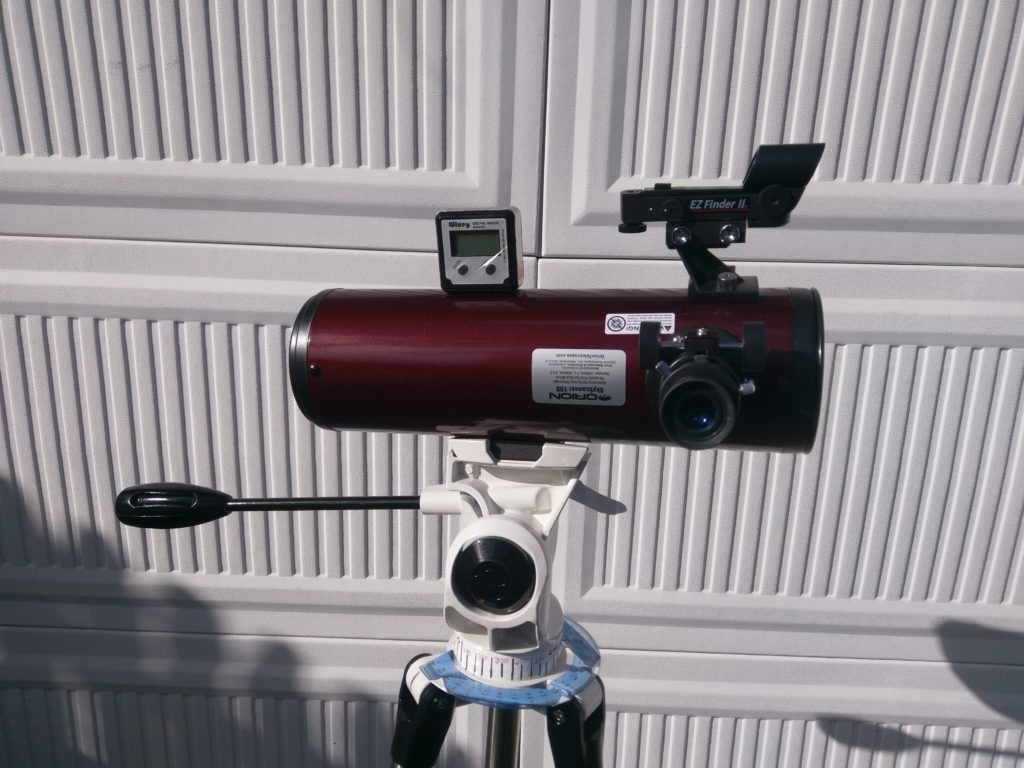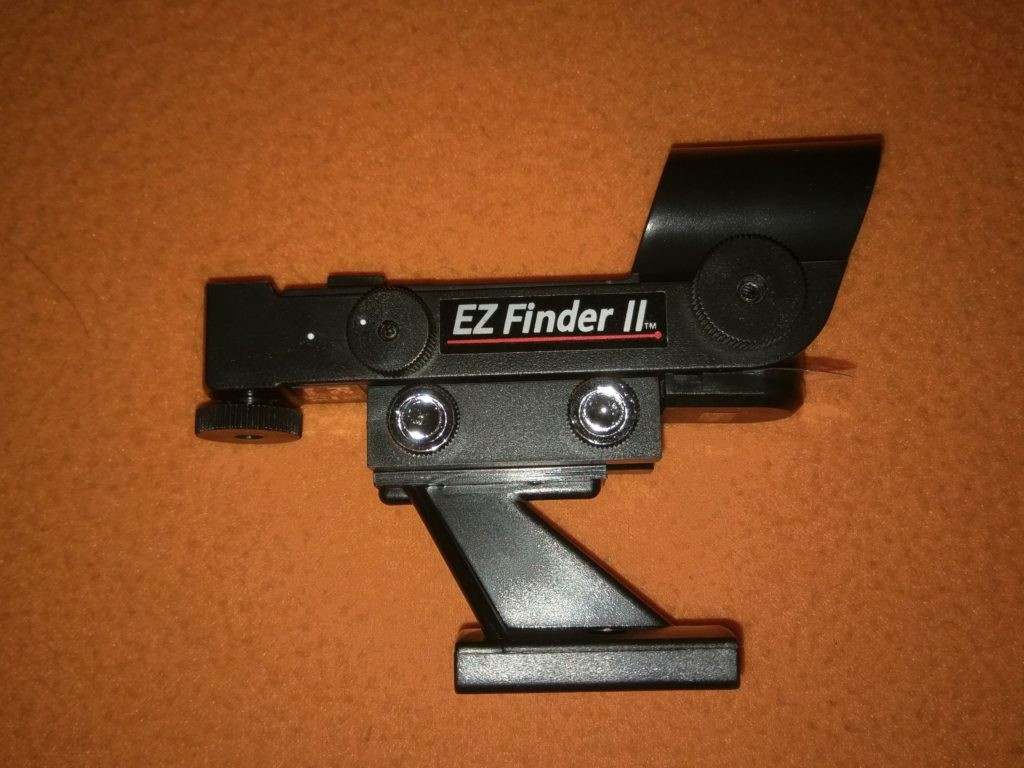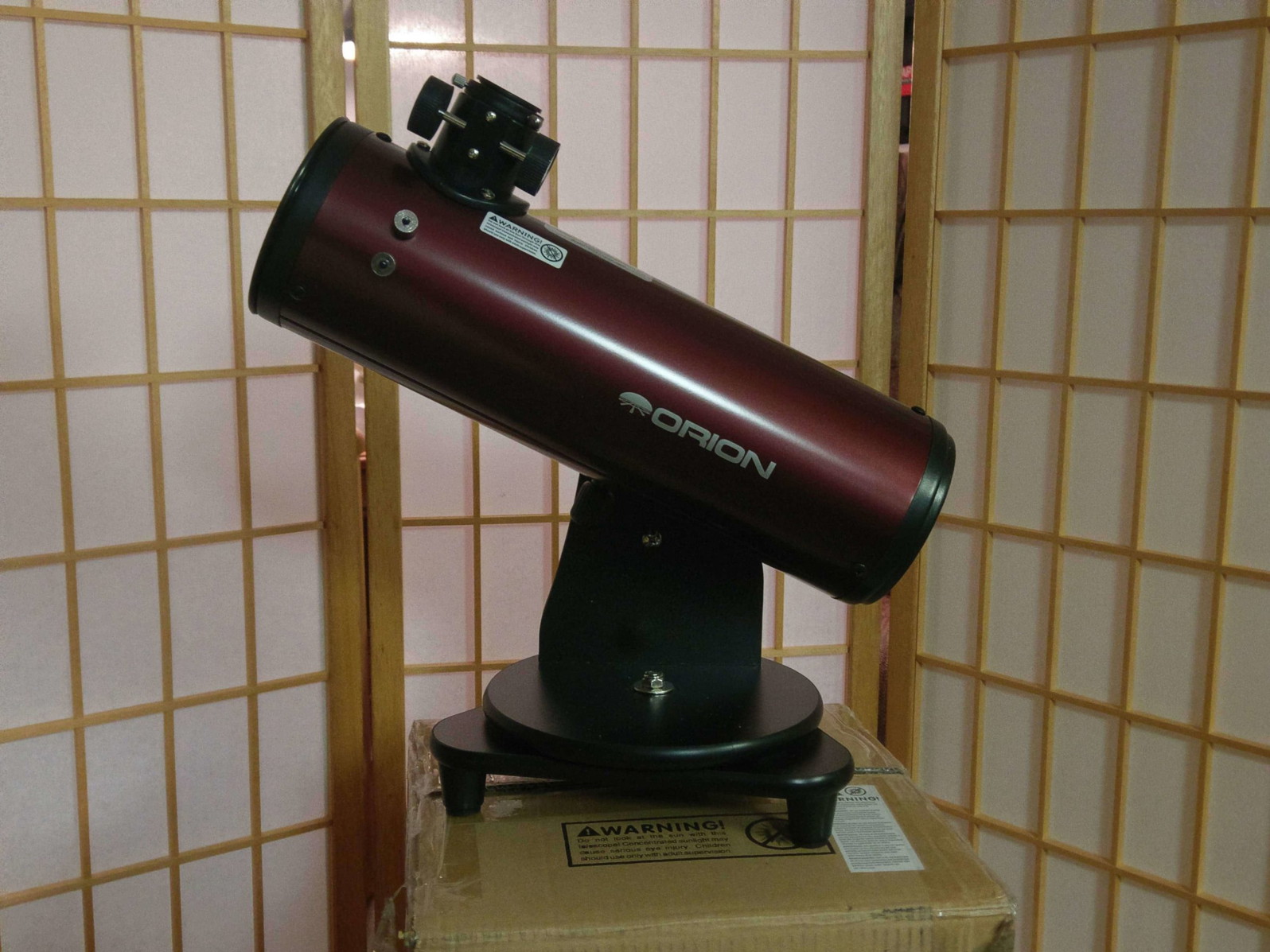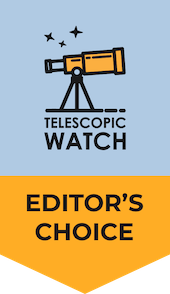The Fixed Primary Mirror
Normally, a Newtonian reflector telescope has a way to adjust the primary mirror to get the optics aligned in a process called collimation, and the primary mirror would normally have a center spot as an alignment target for this collimation process.
The SkyScanner 100 does not have provisions for adjusting the primary mirror, and the mirror is not center-spotted. It is collimated at the factory and fixed in place. This can present problems if the scope is knocked out of collimation during use/shipping, but there are methods (although not exactly easy) that allow one to collimate the primary mirror. But from what I know, the scope tends to hold collimation well over the years.
The secondary mirror can be adjusted for collimation, though this should rarely, if ever, be needed.
I checked my scope’s collimation and it appeared to be on the money. A defocused star test also showed that the scope was properly collimated. As there is no center spot on the primary mirror, there was no reference point to make a precise confirmation, but it looked good to me.
The Focuser
The focuser is a standard 1.25” rack and pinion unit. While plastic, it works surprisingly well even at relatively high magnifications. It was quite stiff when I first used it. Now that I have had it out a few times, it seems to be loosening up a bit.
Mounting the Optical Tube
The intention is that you place this on a table, stool, or some other suitable stand so it is at a comfortable height. It is light enough that even a sturdy box could serve as a base. Just make sure that it is rock solid and steady. I have seen reports of people using it on the hood of their car or placed on a large rock when camping. Just remember that, if the base moves, the image in the eyepiece will show it, so be sure it is stable.
- The included mount is a tabletop Dobsonian style mount.
If you are not familiar with the Dobsonian design, it operates like a Lazy Susan turntable that you might have on your dining room table. The optical tube hangs from an arm using a standard dovetail bar. It pivots on the arm for up and down movement.
You have a tension adjustment dial on the side so you can firm up the friction on the altitude pivot, up and down, so the optical tube stays in place. This will be especially helpful if you buy additional eyepieces that are heavier than the ones that come with the telescope.
The base rotates left and right so it is classified as an altitude/azimuth or AltAz mount. Since the motion is smooth, following targets should be no problem.
Normally, the SkyScanner 100 is used on a table or stand of some type. However, on the bottom of the base is a standard ¼ 20 attachment point, which will allow you to place the entire unit on a photo type tripod or any other kind of tripod or stand that accepts ¼ 20 devices and can support the scope’s 6-pound weight.
- Orion also provides a second mounting option, one I take advantage of from time to time.
You can remove the optical tube from the Dobsonian mount with the twist of a knob and slide the dovetail out of the slot. In the center of the dovetail is another ¼ 20 mount point, so you can attach just the optical tube to the photo tripod. The optical tube alone only weighs 3.4 pounds, which should be well within the weight range of most camera tripods.
If you are traveling and normally bring a camera tripod with you, just pack the optical tube in your bag and use it on the camera tripod. This might make this a great travel scope for airline trips. It is small enough to put in your carryon luggage.
Little details like these ¼ 20 mount points are very thoughtful and useful and not something you typically see in a telescope package at this price. In fact, many entry-level telescopes are attached to their mount in such a way that the optical tube cannot be used on any other mount but the one included in their package. Orion is built to standards that give you flexibility in how you use the telescope.
- A third mounting option is provided by the fact that the optical tube is attached to the table top Dobsonian mount with a standardly sized dovetail.
This also allows you to shift the optical tube forward or back to improve balance if you are using heavy eyepieces. However, if you have another telescope mount that takes a standard dovetail attachment, you can remove the optical tube from the tabletop mount and use it on your other telescope mount as shown in the photo.

When mounted on the included Dobsonian mount, the eyepiece is at the top, which, if you ask me, works well for a tabletop. However, when on a tripod, the eyepiece is at the side, taking advantage of your ability to adjust the height of the tripod.
Accessories
The SkyScanner 100 comes with two eyepieces: 20mm and 10mm Kellners, yielding 20x and 40x, respectively. Testing shows these to be well matched to the scope, giving the new owner a good starting point to scan the sky.
That being said, an aftermarket 6mm “goldline” eyepiece or Barlow lens would allow you to get higher magnification and thus obtain the best planetary views possible with the scope.

This red dot finderscope is the only part of the package that has to be assembled, and it is a simple matter of removing two knurled nuts on the optical tube, slipping the finder over the studs, and tightening them back on.
Don’t forget that the finder must be aligned with the telescope. This is best done during the day before you take it out under the stars.
Alternative Recommendations
Besides the Zhumell Z100, which is essentially identical to the SkyScanner 100, any of our alternative recommendations for the SkyScanner 100 are in higher price brackets:
$200-$250
- The Zhumell Z114’s slightly larger aperture (114mm/4.5” vs. 100mm/3.9”) provides 25% brighter images and 13% more resolving power than the SkyScanner 100mm or Z100, and its primary mirror is also fully adjustable for collimation to achieve the best possible viewing clarity.
- The Orion StarBlast II 4.5 EQ uses the same larger and adjustable primary mirror as the Z114 with otherwise similar performance and features but it comes mounted atop a spindly full-sized EQ-1 equatorial mount and tripod.
Check out our rankings and top picks pages for more information.
What Can You See?
As its name suggests, the SkyScanner 100mm is great for looking up at the sky. The short focal length produces great low power wide field views with the included eyepieces. I would highly recommend using the SkyScanner 100 for scanning the Milky Way if it can be seen from your location.
If you started your journey into astronomy using binoculars and this is your first telescope, you will enjoy having this wide field of view capability. If you were to add a 25 mm Plossl eyepiece to your eyepiece set, you would get a view as wide as 3 degrees, which is wide enough to take in almost all of the Andromeda Galaxy. Most telescopes cannot do this.
Star clusters like the Pleiades, the Hyades cluster, the Dragonfly, the Double Cluster, the Sailboat Cluster, and so many other low- to medium-power deep-sky objects will look wonderful. The Coathanger star cluster, one of my favorite binocular targets, would be outstanding with this telescope.
Using the included 20 mm eyepiece, you get 20X and approximately a 2-degree field of view. This combination will work well for stars hoping to find a wide range of targets. The included 10 mm eyepiece provides a 40X image and about 1-degree field of view. This will work well for the Moon, Venus, and open clusters.
If you want to go higher in magnification for Mars, Jupiter, Saturn, globular clusters, and the like, you will need shorter focal length eyepieces or a Barlow lens. A 3X Barlow would work quite well with the included eyepieces, as it would take the 20X eyepiece to 60X and the 40X eyepiece to 120X. That would give you four magnifications, which would be plenty for most targets and should match up well with the SkyScanner’s capabilities.
You will be able to see the moons of Jupiter and the main cloud bands, as well as the rings and moons of Saturn. With a higher-power eyepiece or barlow, you should have no trouble seeing Jupiter’s Great Red Spot, Saturn’s cloud belts, and the Cassini Division in Saturn’s rings too.
Within the power range of the SkyScanner 100mm, there are hundreds of bright open star clusters you can enjoy, and you can split double stars like Albireo, Mizar, and others. Showcase targets like the Orion Nebula will be wonderful in the SkyScanner 100.
Field Testing
I spent several evenings out with the SkyScanner 100 to test the optics and try it with different eyepieces. Unfortunately, the planets are not in my night sky at this time so I was not able to do specific tests on them.
The Orion Nebula: As a very familiar deep-sky object, I know what to expect. I could see the four stars of the Trapezium at 40X with the 10 mm eyepiece that came with it. I was pleased with that result. Using my 2X barlow, I was able to move in closer at 80X.
Messier 3: On a night with a nearly full Moon, I wanted to try a more difficult target. I looked at Messier 3, a globular cluster in the constellation Canes Venatici, with the SkyScanner. I selected M3 because this can be a challenging target when the Moon is bright, but the SkyScanner did a good job. I had the image up to 80X using the 10 mm eyepiece with my 2X Barlow.
The Moon: Using the SkyScanner 100 on the Moon produces great results with the included eyepieces. The image is clean and sharp. Again, I used the 10 mm with my 2X Barlow to observe the Moon. I had good surface detail and the edges of the moon were crisp with no chromatic aberration. The Moon is usually the target that I can get the highest magnification and still have a good image. That is because it is close and so bright. So I took it up to 149X using a 2.5X Barlow and an Explore Scientific 6.7 mm 82 degree eyepiece. The image quality was quite good, though I found getting into precise focus difficult. The focuser does not do well when fine adjustments are needed, as is required at high magnification. So I am going to say that I feel the scope tops out somewhere around 150X for this reason.
A characteristic of Newtonian reflectors is that if you take the magnification down too low, you may begin to see the shadow of the secondary mirror in the field of view. According to the Orion website, the scope should be able to go down to about 14X, which would be about a 28mm eyepiece. I tested this guess with a 32 mm Plossl, which is what I would normally use to maximize the field of view. The 32 mm provides 12.5X. Surely enough, there was a very distinct dark area in the middle of the field of view. Thus, I would not recommend using an eyepiece of less than 25 mm in focal length, 16X, or you risk seeing the secondary mirror shadow.
I have also tested the SkyScanner 100 with other eyepieces, including my Explore Scientific 14, 8.8, and 6.7 mm 82-degree eyepieces. All worked well in the little scope.
The Messier List is a popular first-observing list for new telescope owners. From my experience, if you can get to a moderately dark location, the SkyScanner will likely be able to show you most of the 110 targets in the Messier Catalog.




One thing you missed is the unusual and awkward position of the focuser — sitting on top of the tube rather than to the side, say at a 45 or 60 degree angle — as it is on nearly all other Dobsonians.
As many people have pointed out on Cloudy Nights, the focuser makes the scope harder to use as one has to look over the top of the scope. Most people prefer the standard positioning. They end up picking the Zhumell Z100 or Z114 or Orion Starblast 4.5 instead.
Monty,
You make a good point. Perhaps it would be better out the side at a 45-degree angle, or something like that. However, I find it quite acceptible on top. I just place it on a lower table when I use it.
Tell me if I’m wrong : the price of this telescope is low but it will get higher if I have to buy a 3x Barlow or a 25 mm eyepiece. It will then price in the 100-175$ range. So is it preferable to get a telescope in this range instead, like the Orion StarBlast II, which is priced at 180$?
Thanks.
Your question is about price vs. value. However, I don’t understand your comparison.
Both scopes are F4. The StarBlast II 4.5 has a 50 mm longer FL. Each would need a similar FL eyepiece or a Barlow to achieve similar magnifications. In that respect they are nearly the same.
I would rate the StarBlast II 4.5 as a better scope based on a larger aperture with an adjustable primary mirror, but that will require maintenance. The SkyScanner primary is fixed and needs no maintenance. I believe the StarBlast II has a better focuser and so should work better at high magnifications.
All are valid comparison points but have nothing to do with the option to get a Barlow or a 25 mm eyepiece. Those are optional on both and would provide similar benefits on both.
Thank you for your reply Ed, I am a beginner and that would be my first telescope. I still have a lot to learn. Thanks again, that helped me make my choice.
You may find this article helpful.
How Much Does a First Telescope Cost?
https://telescopicwatch.com/telescope-cost/
Thank you again for your help Ed. I went to the link and read the text. As it is written, I am as most beginners and look first to see the Moon and the bright planets, Mercury, Venus, Mars, Jupiter, and Saturn. Within my budget and that being my first steps in astronomy, I think of buying the Orion SkyScanner 100 and a a 25 mm Plossl eyepiece or a 3X Barlow (as recommended).
Would it be a good product in my situation?
Thanks again,
Olivier
Sounds like a good fit. I would recommend the Barlow first. The 25 mm will give you a wider field of view but the 20 mm does an OK job too.
I read that sometimes a 2X barlow is better than a 3X with smaller scopes. Can you advise on which magnification would be better for this scope?
There is no answer to that question. We use a Barlow lens to achieve a desired magnification. You pick a 2X if that is what gets you where you want to be. You choose a 3X barlow if that gets you where you want to be.
It all depends on the eyepieces you have and the focal length of the scope.
For example, the SkyScanner 100 comes with a 20 and 10 mm eyepiece set. If you plan to use those eyepieces and you get a 2X Barlow the 20, used in the Barlow is equal to the 10. You have gained nothing in terms of magnification. If you put the 20 in a 3X Barlow you now have the equivalent of a 6.7 mm, a unique focal length and a new magnification option.
If you want to fully understand Barlow lenses, read this article.
https://telescopicwatch.com/?s=barlow
Thanks for doing this review! You said that this telescope and the Zhumell Z100 are “basically the same product”. I like the Z100 better overall, but I really like that the SkyScanner 100 has another ¼ 20 mount point in the center of the dovetail, so I can attach it to my camera tripod. Does the Z100 have that as well? For me this is an important feature and it would be the deciding factor between the Z100 and the SkyScanner 100.
They are not the same product. They are similar, but not the same. The focuser is in a different position, the mount is a bit different and they come with different eyepieces. They would compete directly against each other but they are not the same.
I have never used a Z100 so I can’t say if it has the same mounting point options. However, there is a review here so you can read the comparison.
https://telescopicwatch.com/zhumell-z100-telescope-review/
Thank you very much for this reviewt!!
Do you have a idea of the % of central obstruction, please ? If it is 40% for example ,I m afraid the contrast is not so good , i think . perhaps nearly 30% is the limit (?)
And if i want a “good” small ultra portable scope (!) , a high obstruction will not probably favor this .
I don’t know the answer and Orion Telescope does not seem to provide this specification.
Hi, when I used my 3x Barlow on the Skyscanner, I could not see anything and the focusing was horrible. Could you help me with this? I don’t know whether to get a better 3x Barlow or a Orion 6.3mm eyepiece which will work with my 2x Barlow.
You didn’t tell me what eyepiece you were trying to use or what magnification you are trying to achieve. If you are trying to get over 100X the atmospheric conditions may not be good enough to support that level of magnification with this scope.
You didn’t say what Barlow you were using. I have had Barlows that would not come to focus in some of my scopes and others that would. It is hard to say if that Barlow will work with the SkyScanner unless I have that Barlow.
Once you get over 100X the focuser on that scope can be tricky to get a good focus. It is not that it is bad it is that it is a little coarse in its gearing. This works well at lower powers but can become tricky when trying to achieve high mag. I feel the optics of the scope will support higher mags, over 100X. I place the upper limit at around 150X primarily because of difficulty in fine-tuning the focus. This starts to become an issue above 100X.
Perhaps you have a friend who has a Barlow. Trade and see how it works. That is about the best advice I can provide.
You can read more about Barlows here:
Understanding and using a Barlow Lens
https://telescopicwatch.com/?s=barlow
Hi,Ed. Sorry about that. I actually wanted to use the 10mm eyepiece (40X) provided with the scope along with the 3x Barlow to see how the Moon and the planets look at 120X. I got the Barlow lenses from a trusted manufacturer called Galileo Telescope Makers. But while the 2x Barlow is working perfectly, I don’t why the 3x isn’t. Maybe it may be because of atmospheric conditions?? Thanks a lot for the explanation and the article!!!
Hello!
Your posts frequently come up whenever I search for SkyScanner info, so thank you for sharing all of your experiences with it. I picked one up for my 6-year old and I last summer and had some amazing views of Jupiter and Saturn, even being just a mile away from the lights of NYC.
My only issue so far has been less than ideal places to put the scope on my small, tiled balcony. I’ve tried a variety of portable tables and stands we have around the house, but everything seems wobbly one way or another. I also found a cheap old camera tripod buried in a closet and mounted the scope on without the base, but it was still a bit flimsy. We’re in an apartment and won’t be able to construct that cool homemade tripod. Do you have a recommendation for an entry level photo tripod to use?
Your experience is common with tabletop telescopes. They work well but it can be challenging to find an appropriate table, stool, or stand and to get it to a comfortable height.
I can’t recommend a camera tripod as the one I have is not used for the scope. When I have taken it off the base I have placed it on one of my telescope mounts.
A tip – 4 legged stools or tables are harder to make completely stable, to the level that you require. A three-legged bar stool or side table should work well. That is why we use tripods for cameras and telescopes.
Depending on how much height you need to clear the railing on the balcony, something like this might work:
https://www.amazon.com/Park-Hill-Wooden-Stool-Display/dp/B01LY88ESA/ref=sr_1_21?dchild=1&keywords=3+legged+stool&qid=1624288822&sr=8-21
Avoid something with an adjustable height as that will introduce instability.
Hi Ed I’ve just ordered one of these after reading your review and am eating awaiting it in the post, could you point me in the direction of a fairly affordable 3x Barlow that will work with it? I’m new to all this and would love to see the ring of Saturn search for things like that! Thanks in advance Ollie
Best of luck with that scope. Let me direct you to the article I wrote on using a Barlow. There are recommendations there.
You will definitely be able to see the rings of Saturn with the SkyScanner 100. I use mine as a loaner scope so that friends can get a taste of the hobby that I enjoy so much. As a general statement, I have been quite happy with the GSO Barlows that I own. I have an SVBony Barlow that I team with an SVBony 7-21 zoom that I included with that scope when I loan it out.
Understanding and using a Barlow Lens
https://telescopicwatch.com/best-barlow-lens-and-how-to/
I am looking for a telescope for my daughter, she wants to see the planets and other objects, not so interested in the moon. I have read the reviews and this scope seems the best for under $200 but when you look at the rankings it was given a 2/5 for planetary. So my question what do I buy and if it is still this scope what combination of lenses or eye pieces do I need.
Now that Orion is out of business, the used market will be the only way to get one of these scopes.